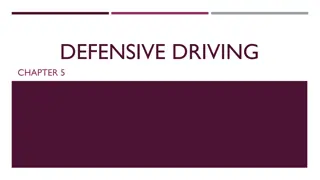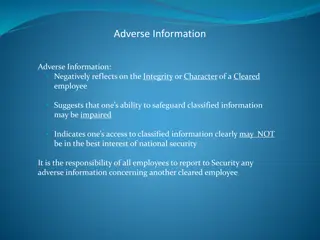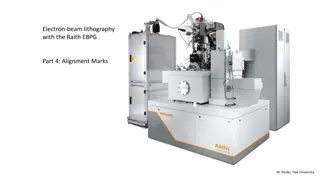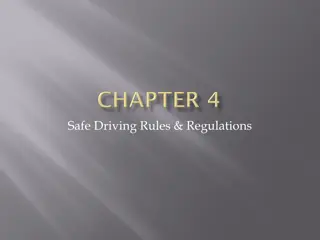Ensuring Safe Driving in Adverse Conditions: Headlight Alignment, Speed, and Visibility Tips
This content covers driver responsibilities in adverse conditions, focusing on topics such as visibility, extreme weather, protecting occupants, roadway technology, and traction loss concerns. Important information is provided on headlight alignment, speed considerations, and nighttime precautionary measures to enhance road safety. Tips on driving in fog and avoiding overdriving headlights are included. These guidelines aim to help drivers navigate challenging conditions and promote safe driving practices.
Download Presentation

Please find below an Image/Link to download the presentation.
The content on the website is provided AS IS for your information and personal use only. It may not be sold, licensed, or shared on other websites without obtaining consent from the author.If you encounter any issues during the download, it is possible that the publisher has removed the file from their server.
You are allowed to download the files provided on this website for personal or commercial use, subject to the condition that they are used lawfully. All files are the property of their respective owners.
The content on the website is provided AS IS for your information and personal use only. It may not be sold, licensed, or shared on other websites without obtaining consent from the author.
E N D
Presentation Transcript
Virginia VirginiaDepartment of Education Module Eight PowerPoint Driver Responsibilities: Adverse Conditions Topic 1 -- Visibility in Adverse Conditions Topic 2 -- Extreme Weather Conditions Topic 3 -- Protecting Occupants Topic 4 -- Roadway and Vehicle Technology Topic 5 -- Traction Loss Concerns Provided in cooperation with the Virginia Department of Motor Vehicles
Headlight Alignment and Speed Topic 1 Lesson 2 The Code of Virginia requires that you use your headlights from sunset to sunrise and during inclement weather, such as rain, fog, snow, or when you use your windshield wipers. At twilight, when the sun light begins to fade, turn your headlights ON. This will make your vehicle more visible to others. Properly aligned LOW BEAM headlights beam hits roadway 100 to 150 feet ahead illuminates area above road 300 to 500 feet ahead load, load distribution, and vehicle height affect light beam distance a maximum safe speed of 40 to 45 mph is based on your ability to stop within the lighted area illuminated roadway 100 to 150 feet lighted area above road 300 to 500 feet T 8.3
Topic 1 Lesson 2 Headlight Alignment and Speed Overdriving your headlights Your vehicle s stopping distance is greater than the distance lighted by your headlights. To determine if you are overdriving your headlights, select an object the moment the headlights pick it up, and count off six seconds. If the object is still ahead of your vehicle, you are driving at a safe speed. If you have passed it, you are driving too fast. Fixed Object 1000 and 1 1 second 1000 and 6 6 second 1000 and 6 6 second Speed is Safe The posted speed limits are calculated for daylight driving and are often too fast for nighttime conditions. Dirty headlights and improper headlight alignment will add to this traffic safety problem. Speed is too FAST T 8.4a
Topic 1 Lesson 2 Nighttime Precautionary Measures Headlights passing or being passed Try to avoid blinding other drivers with your lights Keep your lights on low beam Look to the right edge of the lane or roadway as you pass a vehicle. BGE mirror settings: Set 15 degrees out Don t Wear Dark Clothes Helps reduce the glare from other vehicle s headlights. It reflects it away from the driver. Carry a Handkerchief The day/night lever alleviates the problem of glare reflected from your rear-view mirror. Retro- reflective Material Wear Stripes T 8.6
Visibility Limitations in Fog Driving in Drifting Fog Reduce speed Make sure your headlights are on low beam (aimed at the road surface) to reduce the amount of light/glare reflected back at you Turn on your windshield wipers If necessary, turn on the defroster or air conditioner (air conditioner helps dehumidify the air, which helps dissipate moisture on the windows.)
Visibility Limitations in Fog Driving in Heavy Fog Reduce speed, but NEVER stop in a travel lane Turn on emergency flashers Look for an exit from the highway If impossible to leave highway stop beyond end of guard rail back up to outboard of the guard rail turn off all lights wait for the fog to lift
Precautions in Bad Weather Turn on windshield wipers Be alert for vehicles stopped on the roadway Be prepared for effects of gusting or strong steady crosswinds These crosswinds are called buffeting and can cause strong gusts and blasts of air and can lead to loss of control of the vehicle. Make all steering, accelerating, and braking actions gently and smoothly
Precautions in Bad Weather In severe snow conditions, look for exit from highway and turn on the radio for a weather report If impossible to leave highway, stop beyond the outboard end of guard rail Always clean ALL snow off parked vehicles before driving. Smoke, ice, fog, and snow often require use of windshield washer fluid.
Low Water Crossings Know the depth of the water Slow down so you don t hydroplane Dry brakes after exiting water. T 8.12
Low Water Crossings Nearly 50% of flash flood fatalities are vehicle related Most vehicles will float in as little as 2 feet of water Use your surroundings to estimate water depth. Such as lines on road, fire hydrants, street signs, parked cars, and guard rails. T 8.13
Low Water Crossings Topic 2 Lesson 1 Dry your brakes by pressing on both the gas and the brake at the same time. This makes friction which causes heat to dry the brakes. T 8.14
Hot Weather Checks Tire inflation needs special attention Underinflated tires are subject to heat and pressure buildup due to excessive flexion, especially when driving for extended distances at higher speeds. Underinflated tires are at a greater risk of failure or blowout. The air conditioner, radiator coolant hoses, connections, and drive belts need special attention. due to the extra load placed on these cooling systems. T 8.18
Adjusting Belts for Proper Fit Seat belts should be worn over the strongest skeletal bones Wear Lap Belt low and snug across hips (pelvis) to avoid unnecessary internal injuries Wear Shoulder Beltover collar bone and chest (sternum) to avoid shoulder dislocation and rib cage damage T 8.29
Safety Restraints for Adults Your number one defense to prevent severe injuries is to wear your safety belt. Adjust the seat, place your lower back firmly against the seat and sit up straight. If your vehicle is equipped with an adjustable center post mounting for shoulder belt height, adjust it to the proper height setting so the belt does not rub against your neck. The shoulder belt should go over the shoulder and across the chest and rest against the body. If a crash occurs and a person has not taken the slack out of the shoulder belt, the extra forward movement of the body will increase the chance of injury. The lap part of the belt should be worn low and snug on the hips, barely touching the thighs. If a crash were to occur, the force would then be applied to the strong pelvic bones and not the abdomen, reducing the chance of serious internal injuries. Check frequently for snug fit. T 8.19
Topic 3 Lesson 1 Safety Restraints for Adults Keeping the seat back in an upright position avoids the submarine effect of the lower body in a frontal crash Properly worn seat belts minimize movement of the upper and lower body in a crash Belts dramatically reduce the severity of injuries T 8.20
Safety Restraints for Adults Topic 3 Lesson 1 Air Bags in Dash or Steering Wheel No passenger under 12 years of age should sit in the front seat Protect driver or passengers from sustaining severe head and chest injuries The speed of bag inflation is critical to prevent body contact with the steering wheel The air bag inflates in the blink of an eye, at speeds as high as 200 miles per hour. T 8.21
Safety Restraints for Adults Topic 3 Lesson 1 Air Bag in Steering Wheel Raise seat or adjust steering wheel to direct air bag toward chest and not at the facial area 10 inches Adjust seat for a minimum 10-inch clearance between chest and steering wheel Hand position should be at 8 and 4 Avoid 10 and 2 hand position to prevent blow hole burns to hands and arms T 8.22
Safety Restraints for Adults Topic 3 Lesson 1 Air Bags for side impact protection Located in the upper door frame, side of the seat, or door panel Protect head from hitting the window Side air bag deploys in crash test. Red area shows where the dummy s head impacted the airbag. Head Restraints Proper adjustment minimizes whiplash. Improper adjustment may result in severe neck injury. T 8.23
Safety Restraints for Youth Topic 3 Lesson 1 Belt and Seat Restraint Use Safest if seated in back center seat Infant seats/rear facing/birth to 20 lbs and 1 year. Use child seats up to 40 lbs. Use booster seats up to 60 lbs and 8 years old. Forward Facing Child Restraints Infant Car Bed Rear Facing Infant Seat Booster Seats T 8.24
Types of Belt-Locking Systems Topic 3 Lesson 1 Sudden Car Movement Normal Conditions Emergency Conditions Seat Belt Seat Belt Bar Bar Pendulum Pendulum Ratchet Mechanism Ratchet Mechanism T 8.28
Highway Safety Design Features Occupant Protection Highway Design Features Include Breakaway sign support posts Rumble strips bring attention to your position on the roadway. New design guard rails with ends angled away from roadway and buried Crash attenuators such as vinyl liquid or sand filled drums T 8.31
Topic 4 Lesson 1 Highway Safety Design Features Occupant Protection Highway Design Features Include: Protected left and right turn bays Collector/distributor lanes on high speed, high density highways - separates slower moving entering/exiting traffic from the higher speed through traffic Variable message signs alert drivers to weather conditions, construction, and traffic problems T 8.32
Automotive Technology Anti-Lock Brakes Allow the driver to apply maximum braking power without losing steering control. Traction Control Devices Automatically activates brake sensors if a wheel begins to spin. Electronic Stability Program (ESP) Analyzes where the driver is trying to steer the vehicle and where the vehicle is actually going. If the vehicle is not responding correctly to steering input, any one of the brakes is selectively applied to help the driver regain control. Suspension Control System Adjusts vehicle balance by adjusting the fluid or air pressure of shock absorbers or struts when too much weight is suddenly shifted to a wheel. T 8.33
Dangerous Road Surface Condition Traction is the grip your tires have on the roadway. Road conditions that can affect traction: Ice, snow, or frost Heavy rain or standing water Mud near farm entrances, construction sites, and truck crossings Wet leaves Broken or uneven road surface Sand or gravel frequently found on curves in rural areas Ice Snow Rain Mud T 8.35
Dangerous Road Surface Condition Topic 5 Lesson 1 Wet roadways--particularly the first 15 minutes of rain after a long dry period when oil and rubber particles have collected on the road surface and mix with water On improperly banked or flat curves, traction is more likely to be lost when roads are wet or slippery at slow speeds, or when dry at higher speeds NEGATIVE BANK T 8.36
Causes ofTraction Loss Condition of the Vehicle Brakes unevenly adjusted Brakes pulling in one direction or the other can cause a skid--as can wheels out of alignment when brakes are applied Tires with unevenly worn tread - The size of the front and rear tires do not matched - The tread depth or tire type of the front and rear tires are different Different tire pressure on opposite sides of the vehicle has a similar effect to uneven brake adjustment since one tire will drag more than others T 8.37
Causes ofTraction Loss Driver Actions that may cause loss of traction Sudden steering actions on a slippery surface, or abrupt or sudden changes in vehicle speed Panic stop or applying the brakes too hard on a hill, curve or slippery surface Suddenly engaging the clutch on a slippery surface Most driver-induced skids are caused by: excessive speed coupled with excessive steering input or improper braking when turning Loss of traction also occurs with these driver s actions at normal speeds on ice/snow or on roadways covered by sand, gravel, or water T 8.38
Traction Loss Considerations Sudden shifts of vehicle weight causes traction loss - Left, Right, Forward, or Backward Simultaneous steering, braking and/or acceleration creates sudden shifts in vehicle balance Traction loss compounds crash consequences DROPS LIFTS T 8.39
Traction Loss Considerations When Brakes are Applied Too Hard or Quickly Weight Moves to the Front of the Car Causing a noticeable drop of the hood a noticeable rise of the rear deck forward movement of driver and passengers Rear LIFTS Front DROPS Force or Weight Movement Direction of Travel T 8.40
Topic 5 Lesson 2 Traction Loss Consideration When Acceleration is Applied Too Hard or Quickly Weight Moves to the Rear of the Car Causing a noticeable rise of the hood a noticeable drop of the rear deck rearward movement of driver and passengers Rear DROPS Front LIFTS Force or Weight Movement Direction of Travel T 8.41
Topic 5 Lesson 2 Traction Loss Consideration When Steering is Applied Too Hard or Quickly Weight Moves to the Opposite Side of the Car Weight Movement Causes: a noticeable drop and tilt of the hood a noticeable rise and tilt of the rear deck driver and passenger movement towards the car s corner Force or Weight Movement Front DROPS Rear LIFTS Direction of Travel T 8.42
Traction Loss to Front Tires Topic 5 Lesson 3 If A Vehicle Keeps Moving Straight Ahead in Spite of Steering Efforts To the Contrary, It Means Front Traction Has Been Lost The Technical Term is Called Understeer The Driver Will First Visually Identify Unusual Forward Sliding Movement Caused by the Vehicle s Weight Pushing the Front Wheels Straight Ahead Regardless of Any Steering Input front tires SLIDE rear tires PUSH Intended Path of Travel Actual Path of Travel T 8.43
To Correct Front Traction Loss Topic 5 Lesson 3 Targeted Path of Travel Lift Eyes to Targeted Path of Travel Intended Path of Travel Actual Path of Travel Direct Vision to Targeted Path of Travel Activate ABS, if Vehicle is Equipped Ease off Conventional Brake System Reestablish Rolling Traction Ease off Steering Inputs Abrupt Steering Can Create Traction Loss Allows Tire Tread to Point Toward Path of Travel Jab/Stab Brake to Move Weight Forward if ABS is not Available (ABS performs this function automatically) T 8.44
Traction Loss to Rear Tires Topic 5 Lesson 4 Identified by driver when front of vehicle moves to the left or right of travel path without steering input in that direction Technical term is Oversteer Vehicle s Weight Tends to Push Rear Wheels Left or Right Without Steering Input Vehicle Begins To Yaw front tires ROLL rear tires SLIDE Intended Path of Travel Actual Path of Travel T 8.45
Rear Traction Loss Correction Topic 5 Lesson 4 Direct Vision to Targeted Path of Travel Off Targeted Path Activate Traction Control System, if Equipped: Ease off brake or accelerator Intended Path of Travel Reestablish rolling traction Steer Toward Targeted Path of Travel Adjust Steering Input as Needed to Maintain Targeted Path of Travel Apply Light Progressive Acceleration (2 mph is goal) to Move the Weight to the Rear. (The Traction Control System will adjust the speed and brakes automatically when activated) T 8.46
Off-Road Recovery Do not panic and steer too abruptly Ease off accelerator DO NOT BRAKE Get both wheels off the pavement Steer the vehicle parallel to the roadway If clear, ease back on to the roadway one wheel at a time Limit steering inputs to less than 1/8 of a turn of the wheel Use even less input when the edge of road is high Target the center of the adjacent lane to avoid a Slingshot maneuver into oncoming traffic T 8.47
Off-Road Recovery Topic 5 Lesson 5 Did You Know? In 2002, 53% of the motor vehicle fatalities among 16-20 year olds were caused by run-off-the-road crashes! Source: DMV Traffic Crash Facts T 8.47a























